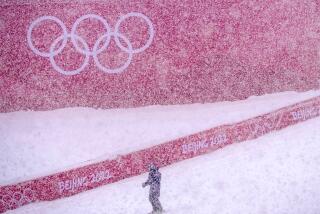Get in Shape for Downhill Vacation : It can take two to three months to get your muscles conditioned for skiing, experts say.
- Share via
The slopes are pristine, the air is crisp and the lift lines are short. What could possibly spoil this ski holiday?
Lack of conditioning could. Every season, people who think they are “ski ready” because they are physically fit--and those who know they’re not but ski anyway--end up sore, injured or both.
It may seem early but now’s the time, experts say, to step up your exercise routine for this year’s ski season or, if you’re already exercising regularly, to focus on specific muscles used most in skiing. It could take two or three months to get in shape for skiing.
No illusions here, though. The best conditioning in the world won’t make you an instant candidate to glide effortlessly down those black diamond runs. Sad but true, the best-conditioned skiers are not always the best skiers, experts concur.
“But physical conditioning will help prevent injury,” said Jim Breazeale, an exercise physiologist and director of performance testing at Centinela Hospital’s Fitness Institute in Culver City. “It will also help increase enjoyment of the activity.”
Ideally, skiers should maintain an exercise program year round, Breazeale and other experts say. (If not, try to get back into workouts at least a few months before ski season.) Year-round exercisers should begin now to focus on “ski-specific” exercises that concentrate on the large muscles in the legs, the calf muscles and the shoulder area, Breazeale and others said. “Start to intensify your program early in the fall,” he suggested.
Many skiers think two or three weeks of dedicated workouts are enough to get in shape for skiing, said Cyndy Reid, fitness director and exercise specialist at Aspen Club International, a health facility in Aspen, Colo. Reid believes it takes a minimum of three months.
Once you begin, focus on the upper leg muscles. “Ski injuries often involve the knee,” Breazeale said. The more stable the knee, the better. “The best brace for your knee is your musculature. Strengthen your quadriceps, the big muscles in front of the upper leg, and the hamstrings on the back of the upper leg. If those muscle groups are strong, they keep the knee well braced. You’ll also be able to ski longer and with more comfort.”
A circuit training program using weight machines to strengthen especially the leg muscles is one way to get ski-ready, Breazeale said. An ideal strategy, he said, is to do aerobic exercise such as running or walking four days a week, provided you’re in good shape or have a doctor’s OK. Supplement that with circuit training three days a week, about 30 minutes a session. Be sure to include work on the leg extension and leg curl machines, Breazeale said.
Step aerobics classes, available now at many health clubs, are another good choice, said Beth Madsen, a 1988 Olympic alpine skier and now a pro racer and independent ski coach. “The step classes work the big muscles in the legs as well as the buttocks,” she said.
Improving balance can help, too, Reid said. She has students in her Aspen Club classes close their eyes and hop in place on one foot. It builds kinesthetic awareness, she said, and helps you “get in tune with how your body feels when it may be off balance.”
Work on flexibility, too. “You’re going to fall,” Breazeale said. “You want to bend but not break. Increase your flexibility especially in the legs.” To improve flexibility, do lots of stretching, focusing particularly on the quads, hamstrings and calves.
“Work on coordination,” Madsen tells skiers. “To improve eye-foot coordination, try soccer or just kick a ball around.”
Consider interval training during your regular exercise routine, which will mimic your efforts on the slopes, Madsen said. “A ski run is at most 2 1/2 minutes long,” she said. “If you run, for instance, run hard for two minutes and then ease up.”
Cyndy Reid does interval training while hiking. She walks up a hill and then back down again, up a bit farther and then down again. The short explosion of exertion followed by less intense activity helps condition you for ski runs, she said, while strengthening leg and abdominal muscles.
Before you ski, be sure to warm up, Breazeale said. Consider a light jog. It will warm up your muscles, which will make them work better and reduce injury risk. (To acclimatize yourself to the higher altitude, take it easy for a day or so after arriving if you can, experts advised, to reduce the risk of altitude sickness.)
If you end up sore despite the best conditioning and warm-up efforts, don’t curl up in a heap and quit, Madsen said. Stretch and massage are better alternatives. “If people stretched more they would not have as much soreness to begin with,” Reid said. She suggests incorporating stretches into a regular routine. “Say you’ve just run five miles. That’s the time to go into long stretches.”
If you can’t get motivated to get into shape on your own, there’s help. A few health clubs offer ski conditioning classes. The Crescenta-Canada YMCA, in La Canada, for instance, has a “Sports Conditioning” class every Monday and Wednesday 6-7:30 p.m. (For more information, call 818-790-0123). There are at-home videos on ski conditioning, too. “Sport Cord Ski Conditioning System” is a half-hour, $89.95 video from SyberVision Systems, Inc., (800-678-0887). “Skiercise II” is a 45-minute, $29.95 program from Rocky Mountain Motion Pictures, P.O. Box 2850, Park City, Utah 84060, 801-649-1030.)
But keep in mind that some experts advise against relying completely on at-home videos, noting that the tapes don’t sufficiently individualize exercise or progress from light to more intense workouts.


